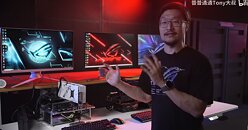- Joined
- Oct 9, 2007
- Messages
- 47,235 (7.55/day)
- Location
- Hyderabad, India
| System Name | RBMK-1000 |
|---|---|
| Processor | AMD Ryzen 7 5700G |
| Motherboard | ASUS ROG Strix B450-E Gaming |
| Cooling | DeepCool Gammax L240 V2 |
| Memory | 2x 8GB G.Skill Sniper X |
| Video Card(s) | Palit GeForce RTX 2080 SUPER GameRock |
| Storage | Western Digital Black NVMe 512GB |
| Display(s) | BenQ 1440p 60 Hz 27-inch |
| Case | Corsair Carbide 100R |
| Audio Device(s) | ASUS SupremeFX S1220A |
| Power Supply | Cooler Master MWE Gold 650W |
| Mouse | ASUS ROG Strix Impact |
| Keyboard | Gamdias Hermes E2 |
| Software | Windows 11 Pro |
AMD is preparing a rather late counter to the Xeon W-2400 and W-3400 series "Sapphire Rapids" workstation platform with the Threadripper 7000 series and the Socket TR5 platform, in the second half of 2023, according to an ASUS product manager. While high core-count Threadripper Pro 5000WX processors still offer performance competitive to the latest Xeon W processors, the Intel platform offers the latest I/O, including support for faster DDR5 memory and PCIe Gen 5. The expectation with the Threadripper 7000 "Storm Peak" series is to increase CPU core IPC with the switch to "Zen 4," and introduce support for the latest DDR5 and PCIe Gen 5.
AMD's delay in releasing the Threadripper 7000 series has to do with the company wanting to push more high-margin EPYC "Genoa" processors to its large enterprise customers first; and possibly to take the time to redraw its platform to better counter the sub-classification Intel introduced within its Xeon W family, where the W-2400 series is targeted more toward the HEDT consumer, with its 4-channel memory and 64-lane PCIe interface; while the W-3400 series with its 8-channel memory interface, targets serious workstation use-cases; while both processors share a common socket and chipset. AMD could take a similar approach to the TR5 platform.

View at TechPowerUp Main Site | Source
AMD's delay in releasing the Threadripper 7000 series has to do with the company wanting to push more high-margin EPYC "Genoa" processors to its large enterprise customers first; and possibly to take the time to redraw its platform to better counter the sub-classification Intel introduced within its Xeon W family, where the W-2400 series is targeted more toward the HEDT consumer, with its 4-channel memory and 64-lane PCIe interface; while the W-3400 series with its 8-channel memory interface, targets serious workstation use-cases; while both processors share a common socket and chipset. AMD could take a similar approach to the TR5 platform.

View at TechPowerUp Main Site | Source




